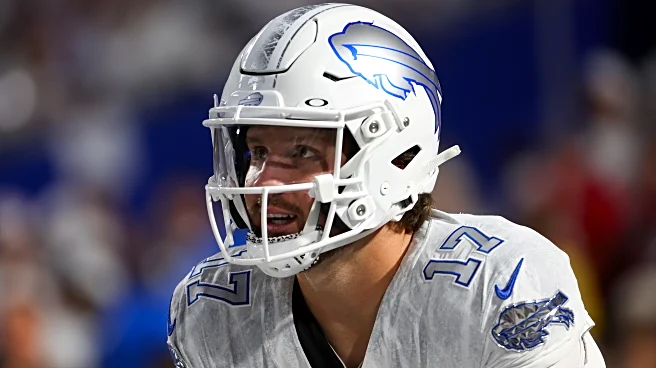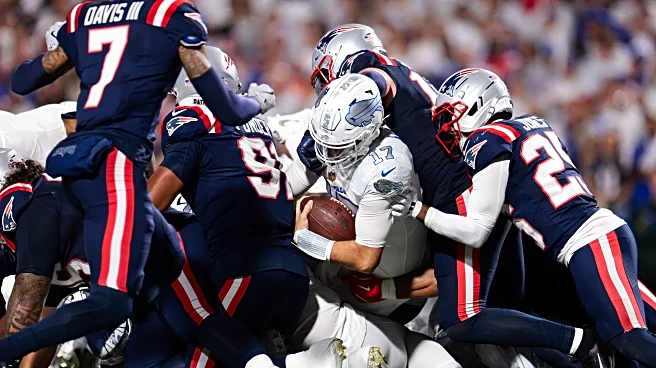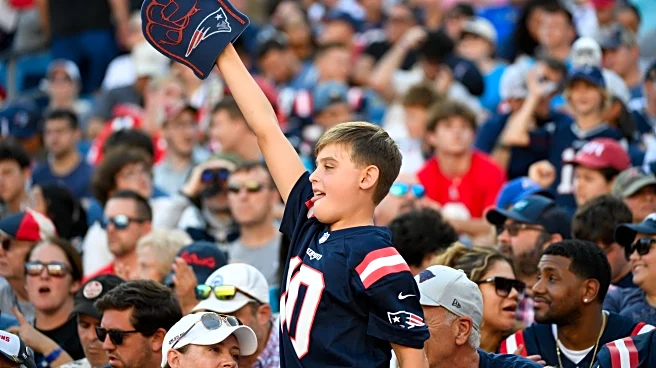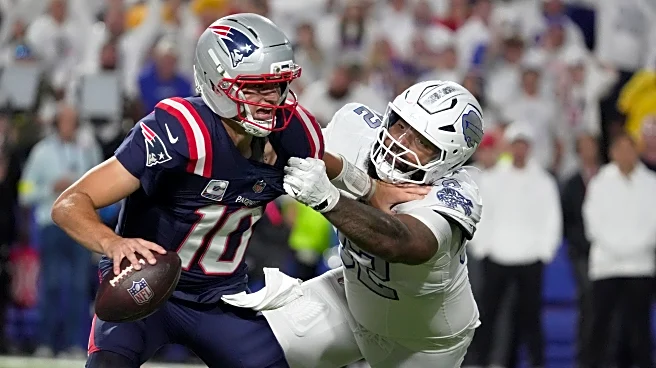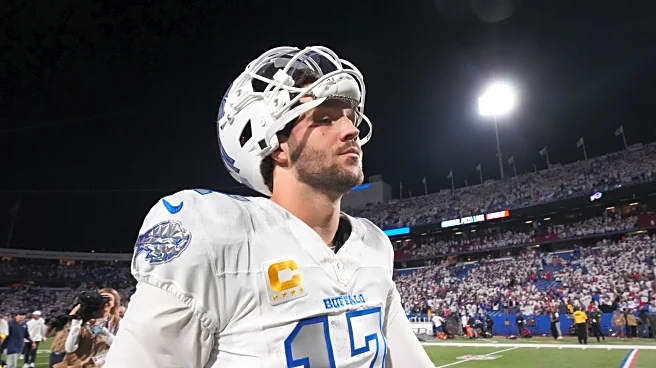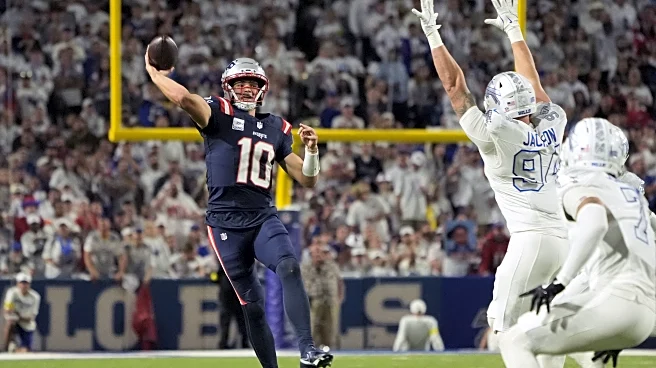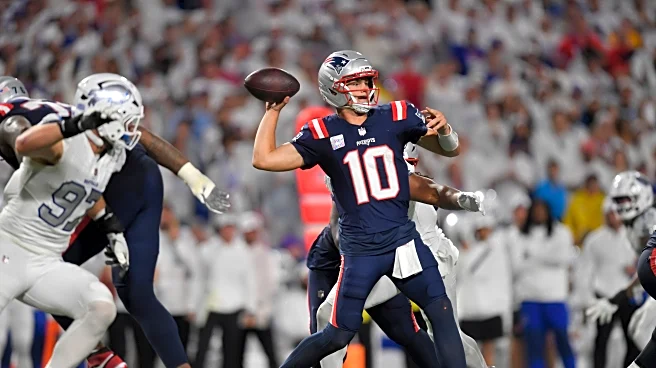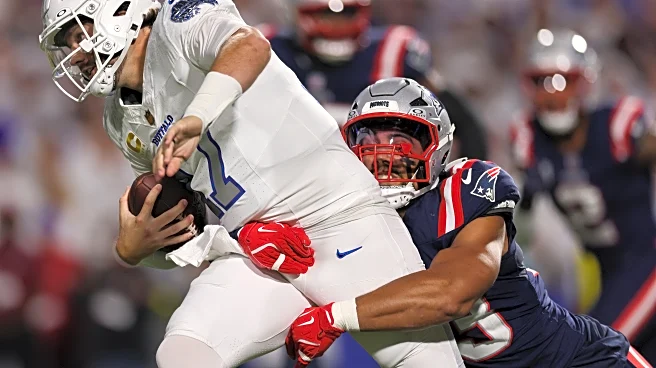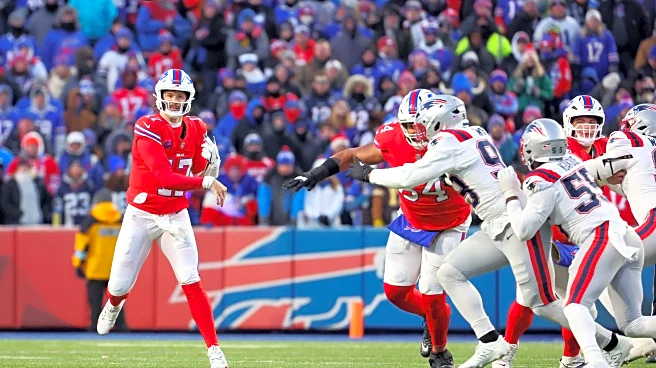The Buffalo Bills’ perfect season ended in Week 5 with a 23-20 loss to the New England Patriots at Highmark Stadium. A 52-yard field goal by rookie kicker Andy Borregales with 15 seconds left sealed the upset,
fueled by Buffalo’s three turnovers — two fumbles and an interception — and 10 penalties for 80 yards. Despite outgaining New England 389 to 354 yards, the Bills went 2-for-4 in the red zone and couldn’t stop Stefon Diggs’ (146 yards) second-half eruption.
Now 4-1, Buffalo faces Atlanta in Week 6, needing to address errors to maintain AFC East dominance. Using box scores, Pro Football Focus (PFF) grades, and advanced metrics like expected points added (EPA) and completion percentage over expected (CPOE), here’s my analysis of the top three trending up, the top three trending down, and some honorable mentions on both sides.
Top three Bills players trending up
These players provided bright spots in a tough night, showcasing skills that could anchor Buffalo’s bounce-back.
1. TE Dalton Kincaid

Making his second appearance in this list in the last three weeks, Kincaid delivered his best game of the young season, hauling in a career-high eight receptions for 112 yards on 10 targets. His PFF receiving grade of 77.5 was the highest on offense, and evident in his crisp route-running that took advantage of mismatches against the Patriots’ linebackers to keep drives alive. Advanced metrics back this up: Kincaid generated +2.1 EPA on his targets, ranking in the 85th percentile among tight ends, per Next Gen Stats.
In a game where Buffalo needed reliable chain-movers, Kincaid’s 17-yard conversion on 3rd & 5 in the third quarter set up a field goal, and his yards-after-catch average (YAC) of 6.2 explain how tough he was to bring down.
After a strong Week 3 (66 yards) and a touchdown in Week 4, Kincaid’s rapport with Allen is blossoming, positioning him as a safety valve amid receiver inconsistencies. The former first-round pick’s upward trajectory is a must to open things up outside, making the wide receivers’ lives easier and Buffalo’s passing attack more dynamic.
2. EDGE Greg Rousseau

After a quiet first four weeks of the season, Rousseau was a disruptive force up front, notching one sack and two tackles for loss (TFL) while registering a PFF pass-rush grade of 82.4 — the second-highest among Bills defenders. His sack on Drake Maye on New England’s opening drive forced a three-and-out, flipping field position early.
Advanced stats shine here: Rousseau’s 18.2% pressure rate on 22 pass-rush snaps ranked in the top 10 league-wide for the week, and his +1.8 EPA from pressures helped Buffalo’s defense generate a 45% win rate on pass rushes (per PFF). Despite the loss, Rousseau’s performance signaled he’s emerging as a disruptor and could create havoc alongside Joey Bosa and Ed Oliver when he’s finally back. As Buffalo faces lefty QB Michael Penix Jr. next, Rousseau’s emergence could be pivotal in creating game-changing plays from his blindside in Atlanta next week.
3. EDGE A.J. Epenesa

Epenesa stepped up with half a sack, one quarterback hit, one pass defense, and two tackles, earning a PFF pass-rush grade of 78.9. His 15.3% pressure rate on 20 pass-rush snaps generated +1.4 EPA, disrupting Drake Maye’s rhythm early, including a second-quarter hit that forced an incompletion.
With Ed Oliver sidelined, Epenesa’s three pressures complemented Greg Rousseau’s output, showing he’s been a valuable role player in the rotation. His Week 4 (1 sack) and Week 5 consistency will be important to continue for Buffalo’s pass-rush going forward.
Top three Bills players trending down
These contributors struggled, with decisions or performances raising concerns.
1. CB Tre’Davious White

White was exposed by Stefon Diggs, who amassed 10 catches for 146 yards (119 in the second half alone). White allowed five receptions for 92 yards when targeted, earning a PFF coverage grade of 49.2 — the lowest among starters. His -2.3 EPA in coverage ranked in the bottom 10% of cornerbacks, with Diggs’ 11-yard first-down catch on the final drive proving costly.
After a difficult 2024 with the Los Angeles Rams and Baltimore Ravens, White’s struggles in Week 5 show yet again that he can’t be counted on as a reliable starter on a good defense anymore. Buffalo’s secondary has been shaky at best in these first five weeks, particularly playing man coverage, and White’s declining athletic ability doesn’t help there.
2. Offensive coordinator Joe Brady

Brady’s play-calling contributed to Buffalo’s season-low 20 points. A second-quarter reverse to tight end Dawson Knox on 2nd & 3 ended in a fumble recovered by New England, costing -2.3 EPA and shifting momentum when the offense was moving downfield just right. The passing game, averaging 6.8 yards per attempt with a -2.8% CPOE on intermediate throws (PFF), hasn’t been consistent, using way too many packages instead of relying on its best weapons and using them more. Also, it needs Josh Allen to create out of the structure way too often, struggling to give the star QB some easy layups to get into a rhythm.
Brady’s failure to incorporate his best skill player, James Cook in the passing game (zero catches and one target despite his 7.8 YAC average and 2.5 receptions per game in Weeks 1-4) limited the offense’s explosiveness. Only 2-of-4 red-zone conversions and 97 second-half yards highlight Brady’s failures calling the pass plays, after having his preferred run-heavy approach (140.5 rush yards per game) contained by New England.
Brady obviously needs his players to execute, and several of them, including his biggest stars, Josh Allen and James Cook, weren’t in their best nights. With that said, nothing comes easy in the Bills’ passing game, something that worries me going forward, especially thinking playoffs.
3. Defensive coordinator Bobby Babich

Babich’s shift to 42% man coverage — up from 28% in Week 4 — exposed the secondary, allowing Drake Maye a 108.4 passer rating when targeting man-covered receivers. Benford, White, and others combined for -3.1 EPA in coverage (Next Gen Stats), as Babich’s scheme didn’t help a zone-built secondary.
New England gained 8.4 yards per pass attempt, with Stefon Diggs consistently beating man coverage, and Maye escaping to his right again and again, without any answer from the Bills’ DC. Even when he had an answer for the Patriots’ QB scrambling ability — Shaq Thompson as a spy — by the time he got to Maye, he was already on the perimeter threatening Buffalo’s secondary. It amazes me how he couldn’t make the necessary adjustments to contain the two main catalysts of the Patriots’ offensive success.
Babich is trying to add some new dynamics to the Bills’ defense, but he must recognize when it’s not working and adjust. Neither of his cornerbacks have played man coverage well, nor are they actually built for it. If he keeps struggling to align his calls with his roster strengths, it might be time for head coach Sean McDermott to take over and fix this unit; after all, it’s his area of expertise.
Honorable Mentions
Trending Up:
LB Terrel Bernard (11 tackles, PFF grade 71.3, +1.2 EPA)
WR Khalil Shakir (5 catches, 58 yards, PFF grade 68.2)
WR Curtis Samuel (2 catches, 26 yards, 1 TD, PFF grade 70.2; increasing snaps at Palmer’s expense)
Trending Down:
CB Taron Johnson (3 catches allowed for 41 yards, PFF grade 55.6; season-long decline)
LT Dion Dawkins (2 sacks allowed, PFF grade 52.8, 2 penalties)
CB Christian Benford (3 catches allowed for 44 yards, PFF grade 57.8)
WR Joshua Palmer (2 catches for 36 yards on 2 targets, but one was a 15-yard gain in the final play of the game, against prevent defense. PFF grade 53.4; It doesn’t look like he is the separator that was sold to us. 51% snap share reflects a declining role)
Catch up on all this and more with the latest edition of Leading the Charge!

